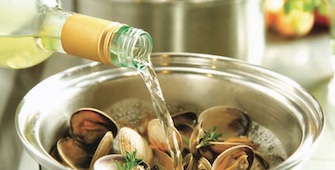Cooking with Alcohol
 Alcoholised beverages played a predominant role in the kitchen until the advent of the refrigerator. The ethanol and the acidity in wine, beer, spirits, and fruit ciders preserve food, acting as antimicrobial and antioxidant agents keeping food fresh longer. The added bonus to these practices was the addition of flavours the alcohol would impart to the food. Marinading meat and pickling fruits and vegetables were common practices similar to how we use vinegar today (incidentally, vinegar is a re-fermented wine, or cider, with acetic acid bacteria). Nowadays, alcohol in the kitchen serves loftier purposes, such as tenderizing meat and imparting flavours and complexity to a dish. Here are a few fun facts and tips to guide you through your next culinary adventures.
Alcoholised beverages played a predominant role in the kitchen until the advent of the refrigerator. The ethanol and the acidity in wine, beer, spirits, and fruit ciders preserve food, acting as antimicrobial and antioxidant agents keeping food fresh longer. The added bonus to these practices was the addition of flavours the alcohol would impart to the food. Marinading meat and pickling fruits and vegetables were common practices similar to how we use vinegar today (incidentally, vinegar is a re-fermented wine, or cider, with acetic acid bacteria). Nowadays, alcohol in the kitchen serves loftier purposes, such as tenderizing meat and imparting flavours and complexity to a dish. Here are a few fun facts and tips to guide you through your next culinary adventures.
It helps to think of alcohol as a food ingredient. Like tomato, lemon or vinegar alcohol adds flavour and acidity to a dish. It binds proteins, herbs and spices creating new complex flavours. The key principle is to match the intensity and the flavours of the alcohol with the other ingredients to avoid overpowering either one. For example, light white wine goes well with delicate white fish, while a robust red wine will be perfect to braised red meat.
Yes, most alcohol will evaporate when cooked. It may take about 2.5 hrs of simmering to reduce a bottle of wine to 4 or 6% alcohol. Still, I have not heard of anyone getting tipsy over a plate of spaghetti sauce or boeuf bourguignon.
And, yes, the quality of the alcohol matters – to some degree. Standard “cooking wine” (something I have never purchased) is a sad plunk infused with additives and even salt. They are best left on the store shelves. Similarly, please do not use a bottle of wine you opened a month ago or left next to a hot stove for days on end. That bottle will be completely oxidized and akin to past- due soured milk. Try a simple, reasonably priced bottle of wine, say $15 to $20 a bottle or a quality box of wine.
Wine or spirits help tenderize and dissolve fats in the meat while releasing flavour molecules of other ingredients in ways not possible when using water, oil or broth. Robust red wine or fortified wines such as port, Madeira and sherry are excellent options in red meat stews, braised roast, gravies and sauces. The long and slow cooking brings the flavours together beautifully, concentrating them. Similarly, wine and tomatoes go particularly well together, adding richness and boldness to the dish. I happily pour half to two-thirds of a bottle of wine into a batch of spaghetti sauces, a stew, or chilli. Add to it sauté mushroom in butter, savoury herbs, and all those Italian and French ingredients and Voilà! You have a winner!
White wines also offer great opportunities in the kitchen. Bechamel sauces are elevated with a splash of white wine. Poaching delicate white fish in a light wine with fresh herbs and green onion adds dimension. And if you do a risotto, please add a generous portion of that rich dry white along with the broth. It will bring complexity and bring balance to the rich buttery finish of the dish.
Of course, a meal is not complete without dessert. That is where sweet desserts and fortified wines, or spirits, shine. Poached pears in port, rum in chocolate cake or pudding, flambé, limoncello cheesecake, brandy pecan pie, orange liqueur cake … you get the picture.
Cooking food with alcohol is easy. Match intensities and flavours, and understand how the acidic nature of the alcohol interacts with the other ingredients. I suggest you follow a few simple recipes at first to familiarize yourself with the cooking approaches. Rich of these experiences, with local autumn vegetable bounties in sight, and a glass of wine in hand, your inner creative chef will soon be unleashed.
Bonne appétit!
Renée Delorme, Sommelier
www.tastingpleasures.ca
403.200.9961
mail@tastingpleasures.ca
Indulge in the pleasures of private tastings



























